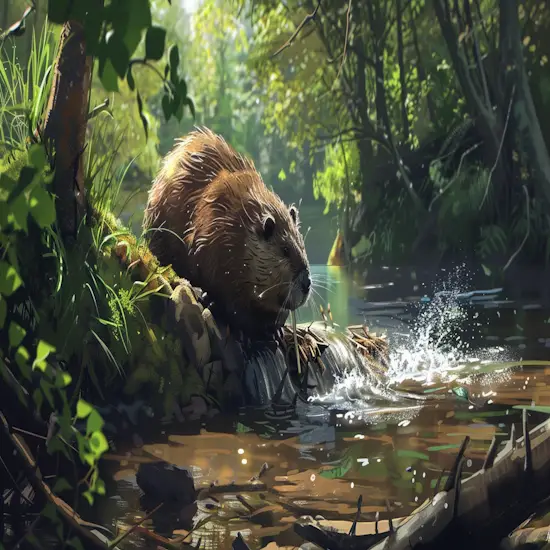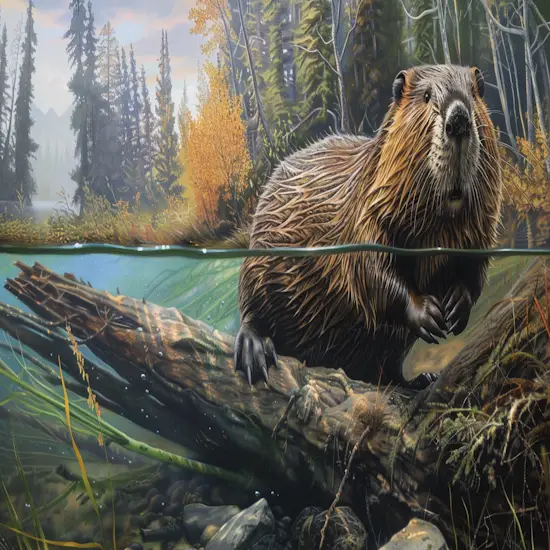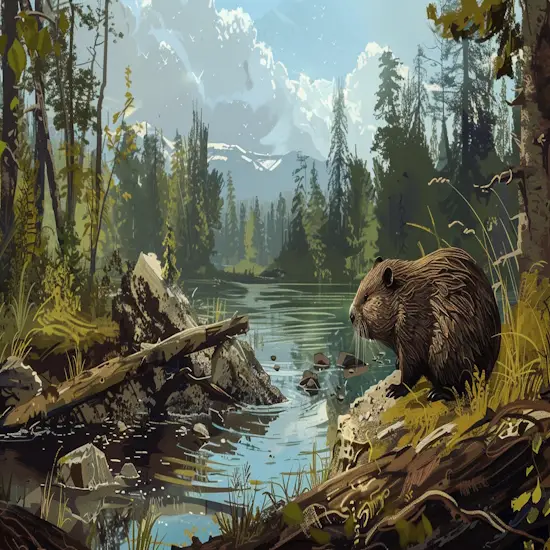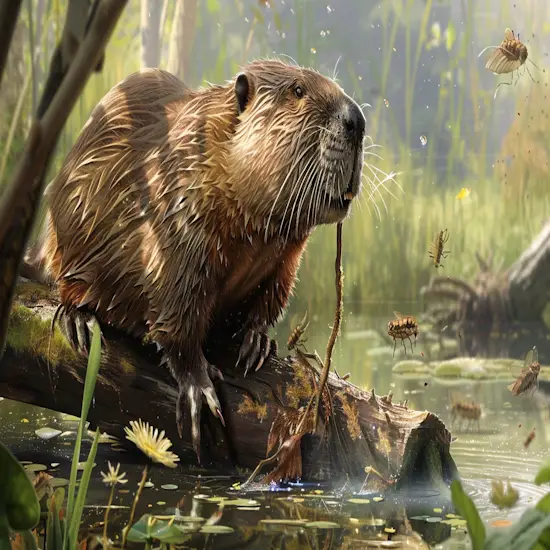Disclosure: We may earn commissions if you purchase products after clicking on a link from our site.
Do you wonder how beavers adapt to their environment? Imagine observing a beaver in its natural habitat, and you’ll start to notice the fascinating ways these creatures have adapted to thrive in their environment. From their webbed feet for efficient swimming to the intricate dams they construct, beavers have honed their skills to guarantee survival. But that’s just the beginning of the story. Have you ever wondered how these adaptations came to be and what other surprising strategies these industrious animals have up their sleeves?

Table of Contents
Key Takeaways
- Webbed Feet aid in efficient swimming and diving.
- Waterproof Fur regulates body temperature and repels water.
- Dams provide protection and access to food.
- An herbivorous diet of aquatic plants and bark sustains them.
- Tight-knit family units with division of labor ensure survival.

Physical Adaptations
You’ll learn about the webbed feet and waterproof fur that beavers possess. These physical adaptations help them navigate through water with ease and stay warm and dry in their aquatic environment. Beavers’ specialized features are essential for their survival and success in their habitats.
Webbed Feet
Adapting to their aquatic lifestyle, you’ll find that beavers have developed webbed feet to facilitate efficient swimming and diving. These webbed feet act like paddles, helping them navigate through water with precision and speed. The webbing between their toes allows for a greater surface area to push against the water, propelling them forward effortlessly.
When swimming, the webbed feet reduce drag, enabling beavers to move swiftly to escape predators or reach their dam quickly. Additionally, these specialized feet aid in diving for food, as they can easily maneuver underwater to gather branches and plants.
With their remarkable webbed feet, beavers have truly mastered the art of swimming and diving in their watery habitat.
Waterproof Fur
Beavers’ adaptation to their aquatic lifestyle also includes having waterproof fur, a physical feature essential for their survival in the water.
Their fur is made up of two layers: a dense, soft undercoat and longer guard hairs on top. These hairs are coated with natural oils that repel water, keeping the beaver’s skin dry even when submerged.
The essential ability of their fur helps regulate body temperature, provides buoyancy, and enables them to stay warm in cold waters. Beavers spend a lot of time grooming to maintain the effectiveness of their waterproofing.
Without this specialized fur, beavers would struggle to thrive in their watery habitat, making it an indispensable adaptation for their survival.

Behavioral Adaptations
Let’s talk about how beavers adapt behaviorally to their environment. They showcase remarkable skills in dam-building and lodge construction, which are vital for their survival. These behaviors are fascinating examples of how beavers thrive in their natural habitats.
Dam-Building
One key aspect of beavers’ behavioral adaptations is their impressive ability to construct intricate dams using a combination of materials found in their environment. Beavers use branches, mud, rocks, and other natural resources to build these structures across rivers and streams. Their dams serve various purposes, such as creating deep ponds for protection against predators and easy access to food during winter.
Lodge Construction
When constructing their lodges, beavers showcase their exceptional behavioral adaptations by utilizing a combination of materials sourced from their surroundings. Beavers exhibit remarkable skills in lodge construction by:
- Gnawing: Beavers use their sharp incisors to cut down trees and branches.
- Dragging: They transport these materials by dragging them to the lodge site.
- Stacking: Beavers strategically pile up the materials to form the walls of the lodge.
- Mudding: They plaster mud over the framework, creating a waterproof seal.
Through these actions, beavers create cozy and secure lodges that protect them from predators and the elements, highlighting their impressive behavioral adaptations to thrive in their environment.

Feeding Adaptations
Beavers have fascinating feeding adaptations that allow them to thrive in their environment. Their dietary diversity enables them to consume a variety of plants and trees, adapting to seasonal changes in food availability.
Additionally, their unique behavior of storing food underwater during winter showcases their exceptional ability to prepare for scarcity.
Dietary Diversity
Adapting to various environments, beavers showcase remarkable feeding adaptations through their dietary diversity. Beavers are herbivores with a varied diet that includes aquatic plants, leaves, bark, and roots. Their ability to consume both aquatic and terrestrial vegetation allows them to thrive in different habitats.
Here are some key points about the dietary diversity of beavers:
- Aquatic Plants: Beavers feed on a variety of aquatic plants like water lilies and pondweed.
- Leaves: They consume leaves from a range of trees such as aspen, willow, and birch.
- Bark: Beavers gnaw on the bark of trees like poplar and maple for sustenance.
- Roots: They also eat roots and tubers, helping them obtain essential nutrients from below the ground.
Winter Food Storage
With the changing seasons, the winter food storage strategies of beavers demonstrate their remarkable ability to prepare for the colder months. Beavers are known for their ingenuity in stockpiling food to survive the winter when resources are scarce.
They collect a variety of vegetation during the warmer months, such as twigs, leaves, and bark, which they store underwater near their lodges. To access this stash during winter, beavers rely on their exceptional swimming and diving skills.

Social Adaptations
Let’s talk about how beavers adapt socially. These animals form tight-knit family units that work together to survive. Communication within these families is key for their cooperation and success.
Family Units
One key aspect of beaver behavior that stands out is how they form tight-knit family units for survival in their environment. Beavers exhibit remarkable social adaptations to thrive in their surroundings. Here’s how they organize their family life:
- Family Structure: Beavers live in family groups consisting of a monogamous pair and their offspring.
- Division of Labor: Each family member has specific roles in tasks like building dams, foraging for food, and caring for the young.
- Communication: They use vocalizations, body language, and scent marking to coordinate activities within the family unit.
- Bonding: Family members share strong emotional bonds, working together to ensure the survival of the group.
Communication
Beavers communicate through vocalizations, body language, and scent marking to coordinate activities within their family unit. They use a variety of vocal sounds like grunts, barks, and whines to convey messages to their family members.
Body language plays an essential role in signaling danger or indicating submission during interactions. Through scent marking with their castoreum glands, beavers leave scents on objects to communicate territory boundaries or reproductive status.
This communication system helps beaver families work together efficiently, whether it’s building a dam, foraging for food, or protecting their lodge. By understanding each other’s signals, beavers maintain a harmonious social structure that contributes to their survival in the ever-changing environment.
The Bottom Line
Beavers are very creative and industrious animals. How beavers adapt to their environment? They have webbed feet, construct dams and lodges, as well as swim well. These skills guarantee their survival but also make them vulnerable to human interference.
In this article, we discussed how beavers adapt to their environment and explained features they use as well as skills that help them adapt. If you want to learn how are beavers important to the ecosystem, then read this article. Additionally, you can also read how to extract castoreum from beavers if you want to know how to do that.
